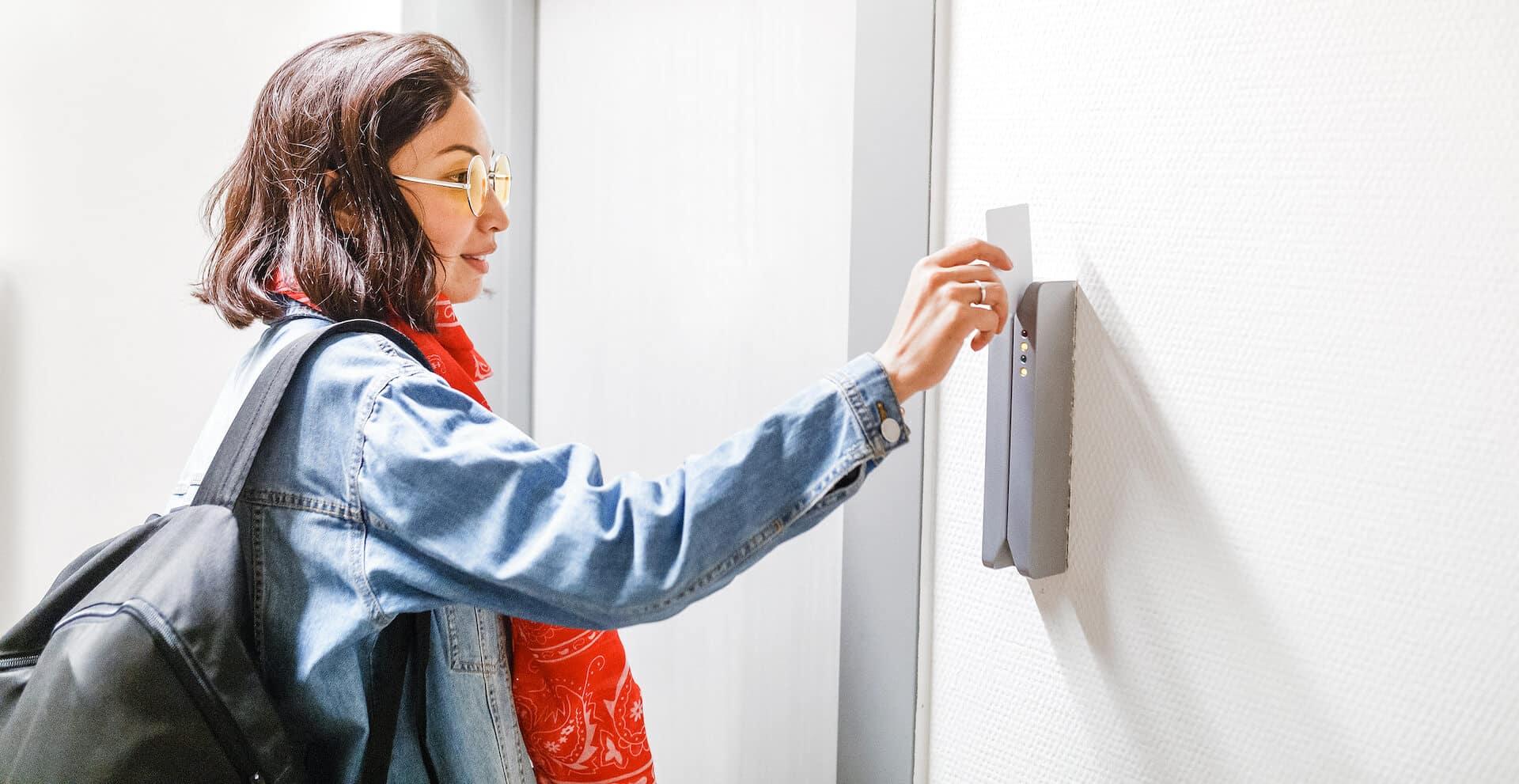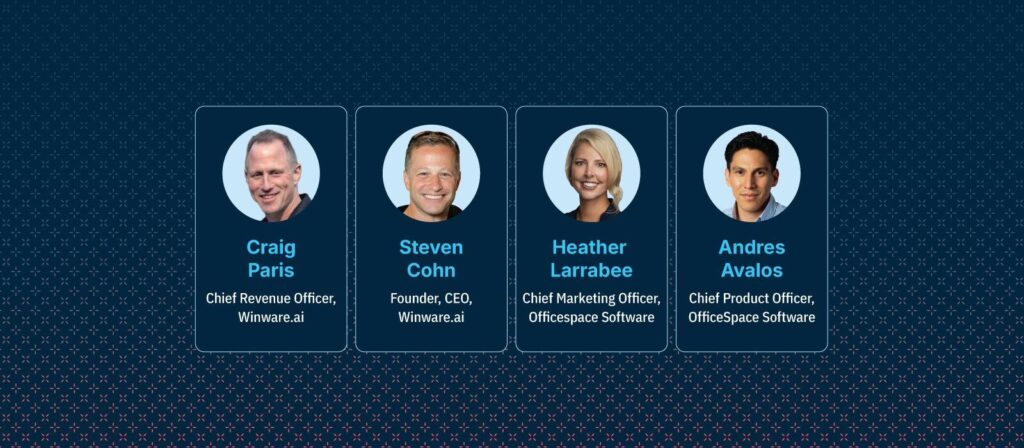Employee badge data is one of the top data sources for managing today’s new hybrid office. Especially when it is combined with real-time workplace reports and analytics, facility managers (FMs) and the hybrid leadership can use this data to build a more accurate picture of actual office use.
This in turn can help improve space utilization and streamline real estate portfolio management. This ultimately helps create a much better hybrid workplace experience, too.
In this article, we explore how to use employee badge data in a hybrid setting. We also include how to combine badge data with other data sources to make more informed decisions for the workplace.
What is badge data—and why do you need it?
Employee badges are typically small cards that have barcodes or other encoding metrics. When employees swipe the magnetic stripe, the card grants (or denies) them access to different areas or resources in the office.
Employee ID badges may or may not be photo ID badges. Regardless, these smart cards ensure that employees (and sometimes visitors) can access things like elevators, working floors, or parking garages—without stumbling into restricted areas or resources.
In turn, badge data is all the information that companies can gather, based on badge use.
Specifically, companies can use the record of badge swipes to figure out the occupancy rate for different areas or workstations in the office. If someone swipes onto a floor, it’s (often) safe to assume they’re working there. More on why badge swipes alone may not offer the truest picture of occupancy below.
Companies and healthcare institutions have long relied on badge systems to manage access control and help keep their facilities safe, secure, and easy to navigate. Especially when used in conjunction with wayfinding signage and other wayfinding initiatives.
But in an increasingly dynamic hybrid workplace, many companies are now also seeing the value in using employee badge swipe data to better understand who is using the office, along with how and when they’re using it.
In fact, OfficeSpace research finds that clients are choosing badge swipe data to track on-site activity use. And using this data more than any other metrics.
But it’s when companies combine this data with other sources of data, they can gain the most reliable insights. And therefore make more informed decisions for the physical workplace.
Types of badges for the office
There are many different configurations for employee badges, ranging from simple RFID cards with just a full name and other employee data (including an employee photo), to a custom ID badge or custom ID card, up to more sophisticated options with biometrics.
Cards are typically made with PVC plastic on an ID card printer (popular options include Magicard, Evolis, Zenius, and Zebra).
Ideally, they will also integrate with smart badging software from companies like Brivo, Kastle, Kisi, and OpenPath.
In fact, it’s specifically when paired with badging software that also collects badge data that they become useful for facility planning and creating a more optimized office.
Badges vs smartphones
We use our smartphones for just about everything these days. So it’s no surprise that some companies are turning to them for badging functionality, too.
By using the right app, an employee’s smartphone can essentially upgrade to a ‘smart badge,’ offering the same authentication and access as traditional badges.
Of course, a smartphone is much more sophisticated than a plastic card.
Specifically, when smartphone badging links to location services, then people can use it to locate employees. And perhaps track their movements too.
This can be extremely beneficial when it comes to security and wayfinding. But of course, it also introduces more concerns around cybersecurity and employee privacy. Any company looking to switch to a smartphone system will therefore need to weigh these benefits and drawbacks carefully.

Why employee badge data isn’t enough
Thanks to the pandemic and the accompanying rise in flexible working options, the office today is increasingly dynamic. And therefore much more difficult to track.
It’s almost hard to believe, but just a few years ago, most employees in most companies had one assigned desk that they were supposed to sit in every day.
This created a stable work environment, and it simplified facility management. All you needed to really track was how many seats you had, and whether they were assigned or not.
Today, employees are sharing desks and using the office sporadically. So despite all the many benefits of hybrid working, it’s much more difficult to get an accurate picture of workflows and office use. This is especially true if you are just relying on one source of data alone.
Yes, badge data is a great tool that can help improve your hybrid work model.
But what if employees forget to badge in?
Or what if their colleague holds a door open for them, letting them ‘tailgate’ into the office?
This is simply human nature, making it hard to police. In fact, one Fortune 500 company found that on an average day, 20% of their employees didn’t badge in, thanks to tailgating.
But let’s assume that a company mandates badging, and creates an arrangement where badging compliance is much more likely.
For example, some companies connect employee badges to the building automation system (BAS). This way, things like lighting and workstations aren’t available unless you swipe in with your credentials. Since employees won’t want to work in the dark, they’ll be much more likely to actually use their badges. Some systems even take this one step further, giving employees more control over their workspaces once they badge in (such as the ability to dim lights or vote on office temperature).
But even in these scenarios, where employees are consistently using their badges properly, badge data still won’t be enough to truly optimize space.
That’s because, again, hybrid workplaces are very different from their traditional counterparts. FMs don’t just need to know whether or not employees are simply in a space. They need to know where they are in that space, for how long, and when.
In short, FMs need to be able to see the nitty gritty of how employees are specifically interacting with their spaces. What types of workspaces are most popular? Are people fighting over certain rooms or certain desks? Are there certain peak times for office use, or certain conference rooms that always sit empty?
To make the right decisions in a hybrid office, you need to know who’s really there. In other words, decision makers need better, more complex data analysis to create a better, more complex hybrid workplaces.
Badge data works best when it’s used in conjunction with other data sources and with space management software to create a fuller, more accurate picture of actual office use.
Not only are companies able to leverage badge data through integrations, but also through a heat map directory in addition to desk and room reservation data.
Other sources of workplace data
Employees today are more or less demanding some amount of flexibility in terms of when and where they work. So many companies are reluctant to actually create strict mandates for office use. But when employees get to set their own hybrid schedule, it’s a fool’s errand to rely on one source of data alone.
True and accurate space optimization today relies on multiple sources of information. Specifically, companies and their facilities teams can and should access a wide variety of the following occupancy data to fully understand office use:
- Presence data
- Desk reservations (along with check-ins and cancellations)
- Room reservations (along with check-ins and cancellations)
- Manual office census (i..e.: ‘walking the floor’)
- Employee surveys/self-reporting
- Wifi logs
- Workplace presence sensors
- Heat maps
- Integrations
- Occupancy sensors through a BAS (such as CO2 sensors)
“My advice to companies is that you can’t rely on just one source of data. Unstructured data won’t cut it anymore. You need to bring your large datasets together to truly solve business problems.”
Kathleen Williams, OfficeSpace Senior Product Manager
Data silos
Finally, collecting lots of data from lots of data sources is great—but it’s not enough. If all this data lives in separate buckets that can’t interact with each other, then they’re not going to provide the full picture you’re striving for.
“With the office becoming more complex, people need more from their data,” says Kathleen Williams, OfficeSpace Senior Product Manager. “They need to look across their information silos and break them down as much as possible.”
In other words, yes, you need badge data. And yes, you need booking data. Also yes, you need employee surveys and the like.
But if all this data is sitting in different software platforms, then you’re not going to be able to combine and synthesize it to create that true picture of office use you want.
True workplace transformation comes when companies truly understand where they are now, and what steps they need to take to get to where they want to be.
So in the age of the hybrid office and advanced analytics, perhaps Steve Jobs’ famous ‘no silo rule’ will need to be tweaked a little.

How to leverage employee badge data for the hybrid office
Like we’ve covered, badge data can be incredibly powerful, but it’s not enough to understand the hybrid office.
No doubt, companies today will be turning to badge swipes to streamline space utilization and better understand their occupancy rates.
This data will work best when it is integrated with a company’s existing Integrated Workplace Management System (IWMS).
This system should be able to synthesize information from different sources, creating useful workplace analytics.
In turn, companies can use these analytics to better plan departments to ensure employees have access to the right resources and types of workstations.
This data can also be used to inform headcount planning, or to help companies see where they might be able to rightsize their real estate portfolio
Companies may also opt to use this rich information to create better, more creative physical workplaces; for example, it can help them determine whether something like agile working or hot desking might work better for their teams.
Security and privacy
Despite all the benefits of collecting badge data (and combining this with other sources), there are two specific concerns with this type of data: privacy and security.
Privacy concerns center around the data that companies collect about their employees, especially if they’re accessing high quality data from smartphones. In theory, companies can now track how active and productive their employees are. Companies are even using cutting-edge (and often wearable) technologies to track things like who employees talk to, how well they sleep, and even their emotions.
Gathering this type of personal information is fraught with privacy issues. Companies who want to proceed should establish clear privacy policies and ground rules, and stick to them.
Meanwhile, collecting and gathering this much data also opens a company up to data security concerns. Even small businesses aren’t exempt from cyber attacks anymore. An employee ID card can be hacked, stolen, cloned, or otherwise compromised. And the data companies collect can also be targeted.
For all these reasons, everyone in the organization should receive regular cybersecurity awareness training. As a rule of thumb, FMs should also work with IT to help shore up security in their building automation systems, and to ensure that everyone on their team has data literacy and an understanding of cybersecurity best practices.

What are the benefits of using ID badges?
Everyone on the team can benefit from using ID badges and the data they can collect.
Leadership should be able to use this data to rightsize their corporate real estate. If they find areas where they can reduce their office space, then that can lead to cost savings.
And they can use this data to also create a work environment that is tailored to employee needs. Employees benefit when their company is able to change and grow with them and their requirements.
OfficeSpace helps companies use employee badge data and a wide range of other metrics to create a full picture of office use. Reach out for a free demo.
Photos: xavierarnau, recep-bg, JohnnyGreig, mixetto




